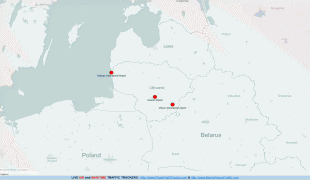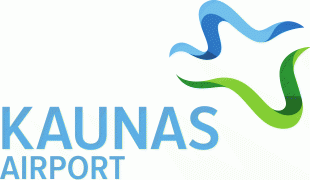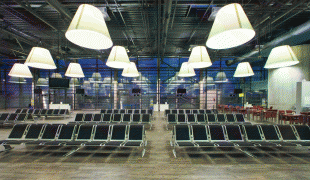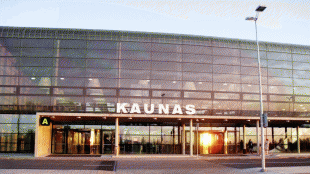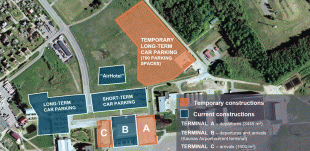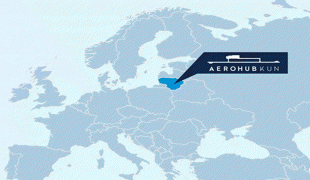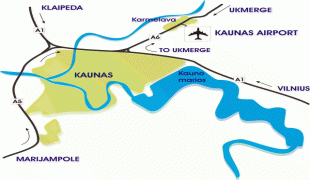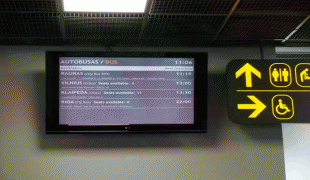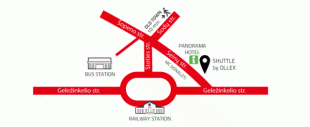Kaunas Airport (Kaunas Airport)
Kaunas Fluxus Airport (Kauno tarptautinis oro uostas), is the second-busiest civil airport in Lithuania after Vilnius Airport and the fourth-busiest in the Baltic states. The airport is located in the central part of the country, 14 km northeast of the Kaunas city centre and 100 km west from the capital Vilnius.
Kaunas Airport started operations in 1988 when airport activities were moved from the historic S. Darius and S. Girėnas Airport, located in the central part of Kaunas city. In 1991, after Lithuania's independence, it gained the status of an international airport and in 1996 it became a member of Airports Council International and began to take part in the activities of the "Lithuanian Airports" association.
Kaunas Airport was used by YAK-40, and YAK-42 of the local Aeroflot branch since 1988. The flight range was moderate and there were some scheduled flights from Kaunas to Kyiv, Kharkiv, Moscow, Odessa, Simferopol, and Šiauliai. Regional airline Air Lithuania based in Kaunas operated scheduled and charter flights from Kaunas to Budapest, Billund, Hamburg, Malmö, and Oslo from 1993 till 2004.
Ryanair started operating flights to Kaunas in 2004. In 2006 it announced establishment of its base in Kaunas. At the beginning of 2013, Ryanair invested more than 3 million euros in a new aircraft maintenance and repair hangar in Kaunas, which currently employs 220 people (2018 data). The airline is further expanding its aircraft maintenance activity at Kaunas Airport, with a planned further investment of 1.6 million euros, which will allow the servicing of twice as many aircraft. The company intends to employ 40 additional aviation mechanics, and the employment strategy is based on the company's collaboration with the Kaunas School of Mechanics at Kaunas University of Technology in order to prepare necessary specialists and invite students for traineeships.
Air Baltic operated Riga - Kaunas daily flights in 2006-2008 and 2009–2014, sometimes reaching up to 2 daily flights.
Wizzair operated Kaunas-Warsaw-London Luton route for a short period of time in 2005. The airline returned to Kaunas in 2012.
Two temporary terminals were in operation in 2017, when Vilnius Airport was closed for reconstruction and flights transferred to Kaunas.
LOT Polish Airlines started operating six weekly flights to Kaunas International from Warsaw on 21 May 2018.
Kaunas Airport started operations in 1988 when airport activities were moved from the historic S. Darius and S. Girėnas Airport, located in the central part of Kaunas city. In 1991, after Lithuania's independence, it gained the status of an international airport and in 1996 it became a member of Airports Council International and began to take part in the activities of the "Lithuanian Airports" association.
Kaunas Airport was used by YAK-40, and YAK-42 of the local Aeroflot branch since 1988. The flight range was moderate and there were some scheduled flights from Kaunas to Kyiv, Kharkiv, Moscow, Odessa, Simferopol, and Šiauliai. Regional airline Air Lithuania based in Kaunas operated scheduled and charter flights from Kaunas to Budapest, Billund, Hamburg, Malmö, and Oslo from 1993 till 2004.
Ryanair started operating flights to Kaunas in 2004. In 2006 it announced establishment of its base in Kaunas. At the beginning of 2013, Ryanair invested more than 3 million euros in a new aircraft maintenance and repair hangar in Kaunas, which currently employs 220 people (2018 data). The airline is further expanding its aircraft maintenance activity at Kaunas Airport, with a planned further investment of 1.6 million euros, which will allow the servicing of twice as many aircraft. The company intends to employ 40 additional aviation mechanics, and the employment strategy is based on the company's collaboration with the Kaunas School of Mechanics at Kaunas University of Technology in order to prepare necessary specialists and invite students for traineeships.
Air Baltic operated Riga - Kaunas daily flights in 2006-2008 and 2009–2014, sometimes reaching up to 2 daily flights.
Wizzair operated Kaunas-Warsaw-London Luton route for a short period of time in 2005. The airline returned to Kaunas in 2012.
Two temporary terminals were in operation in 2017, when Vilnius Airport was closed for reconstruction and flights transferred to Kaunas.
LOT Polish Airlines started operating six weekly flights to Kaunas International from Warsaw on 21 May 2018.
| IATA Code | KUN | ICAO Code | EYKA | FAA Code | |
|---|---|---|---|---|---|
| Telephone | +370 37 399 307 | Fax | +370 37 399 434 | ||
| Home page | Hyperlink |
Map - Kaunas Airport (Kaunas Airport)
Map
Country - Lithuanian_Soviet_Socialist_Republic_(1918–1919)
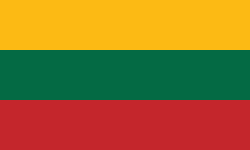 |
 |
| Flag of Lithuania | |
Germany had lost World War I and signed the Compiègne Armistice on 11 November 1918. Its military forces then started retreating from the former Ober Ost territories. Two days later, the government of the Soviet Russia renounced the Treaty of Brest-Litovsk, which had assured Lithuania's independence. Soviet forces then launched a westward offensive against Estonia, Latvia, Lithuania, Poland and Ukraine in an effort to spread the global proletarian revolution and replace national independence movements with Soviet republics. Their forces followed retreating German troops and reached Lithuania by the end of December 1918.
Currency / Language
| ISO | Currency | Symbol | Significant figures |
|---|---|---|---|
| EUR | Euro | € | 2 |
| ISO | Language |
|---|---|
| LT | Lithuanian language |
| PL | Polish language |
| RU | Russian language |






